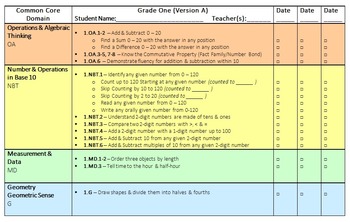First Grade Common Core Math Assessment: Benchmark or Diagnostic
Mathemagicians and Word Wizards Enter Here
89 Followers
Grade Levels
PreK - 2nd
Subjects
Resource Type
Standards
CCSS1.MD.A.1
CCSS1.NBT.A.1
CCSS1.NBT.B.2
CCSS1.NBT.B.3
CCSS1.NBT.C.4
Formats Included
- PDF
Pages
9 pages
Mathemagicians and Word Wizards Enter Here
89 Followers
What educators are saying
A great "short" assessment to give a snapshot of where kids are at benchmarks or for conferences! Took one class period to give so nothing to long!
This is a great assessment to use to find out where your students are at in all the math strands. I trach math intervention k-6 and have this assessment tool for all grade levels.
Description
Mathemagicians and Word Wizards Enter Here for a First Grade Common Core Math Assessment. This test has multiple intended uses. Including:
1. Ensuring an end of the year 1st grader mastered all the Common Core Standards. (Summative Assessment)
2. Ensuring a beginning 2nd grader mastered each of the 1st grade Common Core Standards (Summative Assessment)
3. Placing a 1st grader into an enrichment group. (Screening Assessment) and
4. Determining intervention areas needed to be covered for a student with specialized designed instruction.
(Diagnostic and Progress Monitoring Assessment)
1. Ensuring an end of the year 1st grader mastered all the Common Core Standards. (Summative Assessment)
2. Ensuring a beginning 2nd grader mastered each of the 1st grade Common Core Standards (Summative Assessment)
3. Placing a 1st grader into an enrichment group. (Screening Assessment) and
4. Determining intervention areas needed to be covered for a student with specialized designed instruction.
(Diagnostic and Progress Monitoring Assessment)
Total Pages
9 pages
Answer Key
Included
Teaching Duration
30 minutes
Report this resource to TPT
Reported resources will be reviewed by our team. Report this resource to let us know if this resource violates TPT’s content guidelines.
Standards
to see state-specific standards (only available in the US).
CCSS1.MD.A.1
Order three objects by length; compare the lengths of two objects indirectly by using a third object.
CCSS1.NBT.A.1
Count to 120, starting at any number less than 120. In this range, read and write numerals and represent a number of objects with a written numeral.
CCSS1.NBT.B.2
Understand that the two digits of a two-digit number represent amounts of tens and ones. Understand the following as special cases:
CCSS1.NBT.B.3
Compare two two-digit numbers based on meanings of the tens and ones digits, recording the results of comparisons with the symbols >, =, and <.
CCSS1.NBT.C.4
Add within 100, including adding a two-digit number and a one-digit number, and adding a two-digit number and a multiple of 10, using concrete models or drawings and strategies based on place value, properties of operations, and/or the relationship between addition and subtraction; relate the strategy to a written method and explain the reasoning used. Understand that in adding two-digit numbers, one adds tens and tens, ones and ones; and sometimes it is necessary to compose a ten.


